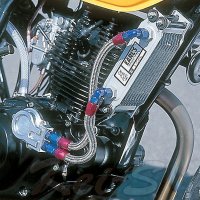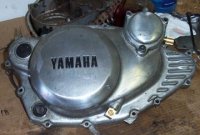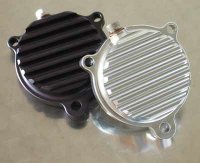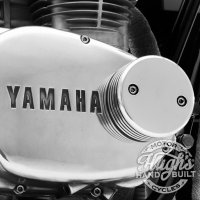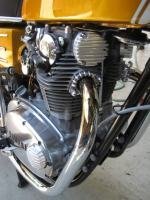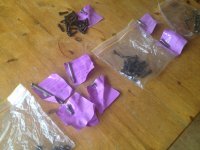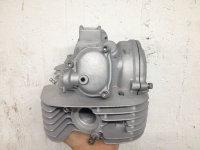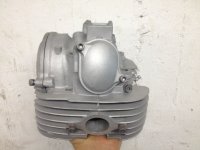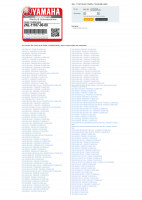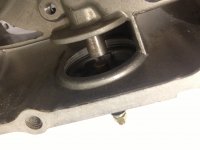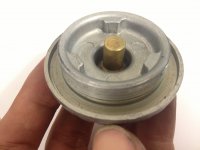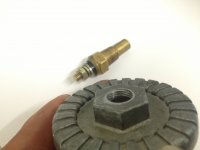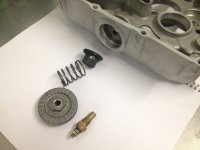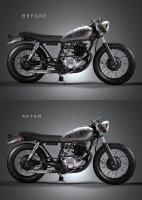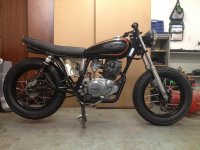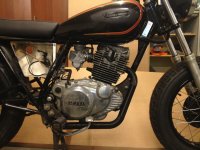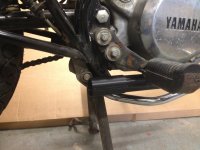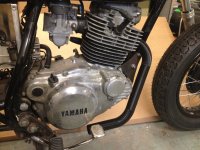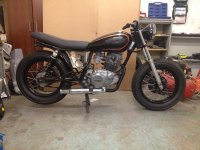We noticed you are blocking ads. DO THE TON only works with community supporters. Most are active members of the site with small businesses. Please consider disabling your ad blocking tool and checking out the businesses that help keep our site up and free.
You are using an out of date browser. It may not display this or other websites correctly.
You should upgrade or use an alternative browser.
You should upgrade or use an alternative browser.
Yamaha SR250 - A clean standard build
- Thread starter JadusMotorcycleParts
- Start date
I agree that the header looks better (for the type of bike being built in this discussion thread) if it closely follows the front frame downtube angle.
I really like this photo:

It shows the header following the downtube angle, then across the bottom of the engine line, and having a little kickup at the end. Good for most street builds that are not using rearset foot controls (e.g., street trackers, urban builds, etc.)
I really like this photo:
It shows the header following the downtube angle, then across the bottom of the engine line, and having a little kickup at the end. Good for most street builds that are not using rearset foot controls (e.g., street trackers, urban builds, etc.)
Yeah your header came out mint. I think I might try making mine tighter to the motor like yours. I'll see what it looks like with the next prototype.
Btw, where did you route your crankcase breather? I see a hose going to the carb boot?
Btw, where did you route your crankcase breather? I see a hose going to the carb boot?
I remember the last SR I built and rode seemed to run pretty cool, but every now and then on a hot Australian day it would start to get real hot, maybe as all air cooled engines do. But I would worry about it because of all the time I had spent on it I didn't want to score bores, burn valves or wear cams unnecessarily due to oil breaking down too fast in the extreme heat.
So I started looking into oil coolers for it... To my surprise, there were/are none. I found that it is a really common mod on the TW200 - see below. But not on the SR. I found an image of a crank case that had been modified to accept some bango/nipple fittings so a cooler could be plumped in (also see below), but no real bolt on kit. I looked into doing the crankcase mod myself and it wouldn't be too hard, but perhaps a little difficult for a hobby builder spinning spanners.
Then, I found some finned oil filter covers - of various designs. But these look like they wouldn't do shit and are more just for decoration. Would I be right? Motolana sells a few different ones: http://www.motolanna.com/ourshop/prod_1916453-Oil-Filter-Cover-Finned-Die-Cast-Alloy.html
http://www.motolanna.com/ourshop/prod_452749-Oil-Filter-Cover-Finned-CNC-Alloy.html
My thinking is that to be able to have any effect, the cover would have to have some small reservoir to A) increase oil capacity slightly and B) to let the oil sit slightly longer (thus cooling a few degrees) before circulating again, pus C) relatively large cooling fins to dissipate the heat. Then I found this cool post by a guy over at the XS650 forum: http://xs650forum.proboards.com/thread/3008/finned-valve-cover-temps
A lot of his parts, testing, discoveries and findings were very interesting and pretty successful it seamed. So this idea could work - design a CNC machined 'proper cooling' oil filter cover for the SR. Then I found the Hugh's Hand Built one they did for the XS and it also seems to have been tested and works well! The part description mentions some of the things I considered... http://www.lowbrowcustoms.com/yamaha-xs650-bolt-on-oil-cooler.html
I rekon I might make a prototype and do some testing! Thoughts?
So I started looking into oil coolers for it... To my surprise, there were/are none. I found that it is a really common mod on the TW200 - see below. But not on the SR. I found an image of a crank case that had been modified to accept some bango/nipple fittings so a cooler could be plumped in (also see below), but no real bolt on kit. I looked into doing the crankcase mod myself and it wouldn't be too hard, but perhaps a little difficult for a hobby builder spinning spanners.
Then, I found some finned oil filter covers - of various designs. But these look like they wouldn't do shit and are more just for decoration. Would I be right? Motolana sells a few different ones: http://www.motolanna.com/ourshop/prod_1916453-Oil-Filter-Cover-Finned-Die-Cast-Alloy.html
http://www.motolanna.com/ourshop/prod_452749-Oil-Filter-Cover-Finned-CNC-Alloy.html
My thinking is that to be able to have any effect, the cover would have to have some small reservoir to A) increase oil capacity slightly and B) to let the oil sit slightly longer (thus cooling a few degrees) before circulating again, pus C) relatively large cooling fins to dissipate the heat. Then I found this cool post by a guy over at the XS650 forum: http://xs650forum.proboards.com/thread/3008/finned-valve-cover-temps
A lot of his parts, testing, discoveries and findings were very interesting and pretty successful it seamed. So this idea could work - design a CNC machined 'proper cooling' oil filter cover for the SR. Then I found the Hugh's Hand Built one they did for the XS and it also seems to have been tested and works well! The part description mentions some of the things I considered... http://www.lowbrowcustoms.com/yamaha-xs650-bolt-on-oil-cooler.html
I rekon I might make a prototype and do some testing! Thoughts?
Attachments
I don't think a cover will do anything - just not enough oil in contact and too small a surface area. The idea of an external cooler might have some merit. But looks are deceiving - see the discussion of an external adapter for the TW200/XT225 vs the XT250 (the newer ones): http://www.thumpertalk.com/topic/973440-xt225-and-tw200-oil-cooler/.
And another oil cooler discussion that seems to favor using an abundance of synthetic MC oil (and a richer tune) rather than adding-on additional plumbing due to cold oil flow and leak issues: http://advrider.com/index.php?threads/adding-an-oil-cooler-to-xt250.956677/.
I know my '94 XT600E has a dry sump (oil in frame) so it would be easy to add the plumbing (but I've not seen any owners who have - the frame surface does a pretty good job) and the Yamaha multi-cylinder street bikes have a front-mounted filter cover that protrudes the entire length of the filter. But even in those cases a filter cover adapter is used to plumb-in an external cooler rather than using filter cover fins or something else.
And another oil cooler discussion that seems to favor using an abundance of synthetic MC oil (and a richer tune) rather than adding-on additional plumbing due to cold oil flow and leak issues: http://advrider.com/index.php?threads/adding-an-oil-cooler-to-xt250.956677/.
I know my '94 XT600E has a dry sump (oil in frame) so it would be easy to add the plumbing (but I've not seen any owners who have - the frame surface does a pretty good job) and the Yamaha multi-cylinder street bikes have a front-mounted filter cover that protrudes the entire length of the filter. But even in those cases a filter cover adapter is used to plumb-in an external cooler rather than using filter cover fins or something else.
cosworth
Coast to Coast
I used ot run a K&N filter to atmosphere. The single cylinder oil consumption with that is alarmingly high. It has to cycle in and out of the crankcase, where a twin just replaces it's own displacement on opposing strokes within the crankcase.
So, I decided to change it to a piece of aluminium I made on the lathe, JB welded into the intake boot after a careful drilling. Trying to create a constant vacuum from peristatic/venturi effect.
The rushing air past the carb creates a vacuum. The vacuum in a thumper crankcase should minimise the oil loss from a pressurised crankcase pushing past the rings and seals.
I've been slowly drilling the hole larger to see when it works best without sucking anything liquid as opposed to oil fog.
Oil levels in these motors needs to be really monitored well since the camshaft needs to get all the oil it needs.
So, I decided to change it to a piece of aluminium I made on the lathe, JB welded into the intake boot after a careful drilling. Trying to create a constant vacuum from peristatic/venturi effect.
The rushing air past the carb creates a vacuum. The vacuum in a thumper crankcase should minimise the oil loss from a pressurised crankcase pushing past the rings and seals.
I've been slowly drilling the hole larger to see when it works best without sucking anything liquid as opposed to oil fog.
Oil levels in these motors needs to be really monitored well since the camshaft needs to get all the oil it needs.
Cosworth - What you describe is very similar to the OEM setup where the crankcase hose connects directly to the air filter box. I would have thought you would be using a good-quality oil catch can (https://torquepost.wordpress.com/2013/05/06/oil-catch-cans-what-you-should-know-how-the-work/) to ensure NO oil returns into the intake tract.
cosworth
Coast to Coast
I've tried catch cans and other rigs. I'm full circle and I would rather have the oil slightly contaminating the air fuel mixture, like stock, rather than have my piston forcing air out and getting oil consumption that rivals a two stroke.
After tearing down a few sr250 motors now, I'm far more interested in oil supply than .2 of a horsepower more from the motor. I'll just take a really big dump before I ride instead.
After tearing down a few sr250 motors now, I'm far more interested in oil supply than .2 of a horsepower more from the motor. I'll just take a really big dump before I ride instead.
zap2504 said:I don't think a cover will do anything - just not enough oil in contact and too small a surface area. The idea of an external cooler might have some merit. But looks are deceiving - see the discussion of an external adapter for the TW200/XT225 vs the XT250 (the newer ones): http://www.thumpertalk.com/topic/973440-xt225-and-tw200-oil-cooler/.
And another oil cooler discussion that seems to favor using an abundance of synthetic MC oil (and a richer tune) rather than adding-on additional plumbing due to cold oil flow and leak issues: http://advrider.com/index.php?threads/adding-an-oil-cooler-to-xt250.956677/.
I know my '94 XT600E has a dry sump (oil in frame) so it would be easy to add the plumbing (but I've not seen any owners who have - the frame surface does a pretty good job) and the Yamaha multi-cylinder street bikes have a front-mounted filter cover that protrudes the entire length of the filter. But even in those cases a filter cover adapter is used to plumb-in an external cooler rather than using filter cover fins or something else.
Thanks for the links. I think you're right. Which means that these finned oil filter covers are just for looks. Makes me wonder about the whole Hugh's Handbuilt one too. But this guy (http://xs650forum.proboards.com/thread/3008/finned-valve-cover-temps) actually did some testing and it seems he got cooler temperatures with the finned valve and timing covers than he did with the spoiled filter cover. Makes sense too - dissipate heat at the head, where the oil would be the hottest and don't mess with any of the plumping - so not to much up any flow or cause starvation anywhere. I also know that the SR spits oil up into the valve covers for it to then condensate, collect and then drip (via a 'v' in the casting) onto the valve tappets. Maybe there is more merit in that direction? Like that guy says - finned valve covers came stock with Nortons and some other old British bikes...
From the guy that made the parts: 'I’m still not sure how well the finned oil filter cover will dissipate heat. I have to run it a while to see.
The end result using my laser temp meter, with the same ambient temperature of 87 degrees before and after the covers were added. Traveling around town as well as a three mile stretch at 55 mph the finned covers dropped the head temperature from 230 to 197 degrees taken at the front two valve covers. The finned oil filter seemed to have less of an effect on this trip. The crank case below the cylinders was 175 degrees before and with the finned oil filter cover I got 167 with a surface temp of the fins being at 116 degrees. These are just my initial findings and I think I could get a better assessment on a longer trip, but at this point I feel safe in saying I gained something for my effort. I think the finned oil filter cover may have more benefit with longer sustained freeway speeds. With the limited surface area inside the cover I will need the differential between the fins and the oil temp, so I’ll check the temps again on the next long trip.'
Attachments
cosworth said:I've tried catch cans and other rigs. I'm full circle and I would rather have the oil slightly contaminating the air fuel mixture, like stock, rather than have my piston forcing air out and getting oil consumption that rivals a two stroke.
After tearing down a few sr250 motors now, I'm far more interested in oil supply than .2 of a horsepower more from the motor. I'll just take a really big dump before I ride instead.
Thanks for that. Did you add any kind of one-way/check valve? Or is it really just air/worst case oil 'mist' that ends up coming out of the breather? I think your set up looks better too.
Good points about the performance/oil supply. I think upgrades to 'wake up' the motor are well worth it - simply because it is far from its potential. But trying to get bigger hp gains are not worth it. I have tried once in the past (may still do again), I will share that project one day haha
I also decided to work on a black hex head bolt kit for the engine. I know there is a stainless one available out there but I just don't like what stainless and aluminium do together (or the shininess actually) and I really like the look of the black bolt heads on some clean engine cases 
Attachments
cosworth
Coast to Coast
JadusMotorcycleParts said:Thanks for that. Did you add any kind of one-way/check valve? Or is it really just air/worst case oil 'mist' that ends up coming out of the breather? I think your set up looks better too.
Good points about the performance/oil supply. I think upgrades to 'wake up' the motor are well worth it - simply because it is far from its potential. But trying to get bigger hp gains are not worth it. I have tried once in the past (may still do again), I will share that project one day haha
I looked into a check valve from an exhaust system from the 70's. It was very robust. Mercedes makes one that can oscillate quickly as well. The idea is to have negative pressure in the crankcase, not positive pressure. Thumpers are unique in this regard. As the piston goes up and down it creates positive/negative pressure in the crank. The oil mist has to go somewhere. Since going back to the tube from the vent alone, the bike doesn't weep from the case anymore. The oil consumption is down. But not down enough. I'd like to get three tanks without adding oil or having to check it.
8) It might also be interesting to see if the valve adjustment covers used on the SR250 were used on other Yamaha models (or would fit even if they were not the same part number).JadusMotorcycleParts said:But this guy (http://xs650forum.proboards.com/thread/3008/finned-valve-cover-temps) actually did some testing and it seems he got cooler temperatures with the finned valve and timing covers than he did with the spoiled filter cover. ~~Maybe there is more merit in that direction? Like that guy says - finned valve covers came stock with Nortons and some other old British bikes...
zap2504 said:8) It might also be interesting to see if the valve adjustment covers used on the SR250 were used on other Yamaha models (or would fit even if they were not the same part number).
Good idea Zap. I actually did that and it was really surprising - check this out, first a list of bikes with the same oil filter cover part number (not so many), then a list of bikes with the same valve cover part number - insane! I cant seem to find an alternative aftermarket design either so I think I'm gonna give it a crack. Will just try and make the fins match the head and make it as good looking and as thermally effective as possible. So I took some photos of the head for reference when I start designing the parts in CAD.
(btw, the exhaust cover on this head is from a tt250 - hence the fittings for a decomp lever) but I will be designing a standard SR250 one instead.
Attachments
For once I have decided I should think a bit about this idea before I dive into design and prototypes. So for me this means setting up for some serious testing. If I am going to design, make and sell parts, I want them to be tested and proven to actually work/function/serve a purpose. So many of the finned cover products for sale online right now claim to reduce oil temperature because of better heat dissipation. This must be bullshit because I have never seen any tests or actual numbers.
The plan is to install 3 temperature sensors, plus an oil pressure sensor. One temp sensor will be in the typical place being the head - spark plug fitting, one will be in the sump (ie. before the oil has passed through the oil filter) then one just after the oil filter - after the oil has passed through the filter and filter cover. This way I will be able to get an oil temperature before and after its journey through the oil filter and cover, plus have a test constant - being the head temperature. I will install 1/8''-27 NPT fittings for the sensors and be able to do before and after comparisons. I will test the stock cover, a couple of different aftermarket covers bought online, plus my design. I think this approach will yield much more accurate/reliable results than using a laser pointer heat/temp gun.
With the oil pressure, I will do a test with the stock filter cover, then a test with my design and see if there is any difference. If there are any pressure losses, I will call it a fail and abandon the project.
Today I installed the first one - in the sump plug. I made sure it doesn't block/foul the oil pick up in anyway. But the sensor head will be fully emerged in the oil so it should give a pretty accurate result.
I learned something new today too, something that to many of you will be a 'duh, you idiot' kinda thing... I found out that NPT threads/fittings have a taper! Haha. When I was tapping the thread in the sump plug, I was wondering why the deeper I went, I was getting more resistance on the tap. Now I know Lucky I didn't go too deep!
Lucky I didn't go too deep!
The plan is to install 3 temperature sensors, plus an oil pressure sensor. One temp sensor will be in the typical place being the head - spark plug fitting, one will be in the sump (ie. before the oil has passed through the oil filter) then one just after the oil filter - after the oil has passed through the filter and filter cover. This way I will be able to get an oil temperature before and after its journey through the oil filter and cover, plus have a test constant - being the head temperature. I will install 1/8''-27 NPT fittings for the sensors and be able to do before and after comparisons. I will test the stock cover, a couple of different aftermarket covers bought online, plus my design. I think this approach will yield much more accurate/reliable results than using a laser pointer heat/temp gun.
With the oil pressure, I will do a test with the stock filter cover, then a test with my design and see if there is any difference. If there are any pressure losses, I will call it a fail and abandon the project.
Today I installed the first one - in the sump plug. I made sure it doesn't block/foul the oil pick up in anyway. But the sensor head will be fully emerged in the oil so it should give a pretty accurate result.
I learned something new today too, something that to many of you will be a 'duh, you idiot' kinda thing... I found out that NPT threads/fittings have a taper! Haha. When I was tapping the thread in the sump plug, I was wondering why the deeper I went, I was getting more resistance on the tap. Now I know
Attachments
Time to post something a little more visually appealing... Here is a mate of mines bike. He built this in 2013 in Melbourne (was his first build) and he did a rad job. I love the style of it.
With his permission, I got hold of his studio shots (hes a photographer as well) and Photoshopped in the seat I have designed. I also worked in the results of installing the tank lowering/leveling kit. This is no exaggeration either, the results are exactly how the kit would look. If anything, I think the kit has had the most drastic effect. It disturbs me so much that so many SR builds get ruined (imho) by this leaned back angle of the tank - the remains of the try-hard, wanna-be chopper theme. Had they just installed this kit (or fabbed up something themselves of course), the tank would then line up with the rear frame rails and the whole bike would be much more harmonious 8)
Another big thanks to Henry as well for letting me do this. Cheers bud.
With his permission, I got hold of his studio shots (hes a photographer as well) and Photoshopped in the seat I have designed. I also worked in the results of installing the tank lowering/leveling kit. This is no exaggeration either, the results are exactly how the kit would look. If anything, I think the kit has had the most drastic effect. It disturbs me so much that so many SR builds get ruined (imho) by this leaned back angle of the tank - the remains of the try-hard, wanna-be chopper theme. Had they just installed this kit (or fabbed up something themselves of course), the tank would then line up with the rear frame rails and the whole bike would be much more harmonious 8)
Another big thanks to Henry as well for letting me do this. Cheers bud.
Attachments
Today I put together the next exhaust prototype, with changes influenced by your inputs! The exhaust is now much tighter in to the frame and engine at the front (maybe too much? Is it nicer with a small gap there to distinguish between frame and exhaust? Visually?) and also much tighter to the underside of the engine.
I am in two minds about where to end the exhaust/how long to make it. One idea is to make it extend right past the brake pedal and foot peg so the clamps and everything clear that. The other option is to make it shorter so that the clamps and everything clear the foot brake and foot peg in front instead. They both look pretty cool. And from what I have tested, there is no problem with interference (with the short version) when attaching a silencer - I have fitted this old school style exhaust you see in the picture as an example - in the photo its hanging down a bit because i didn't attach it properly, its just sitting there. But a 17'' and 26'' reverse megaphone muffler, plus a hot dog silencer will fit...
Should I just make it longer and customers can cut to their desired length themselves? Then instead of welding the adapter to the end, just include it as a loose accessory to place on after it has been cut?
I am in two minds about where to end the exhaust/how long to make it. One idea is to make it extend right past the brake pedal and foot peg so the clamps and everything clear that. The other option is to make it shorter so that the clamps and everything clear the foot brake and foot peg in front instead. They both look pretty cool. And from what I have tested, there is no problem with interference (with the short version) when attaching a silencer - I have fitted this old school style exhaust you see in the picture as an example - in the photo its hanging down a bit because i didn't attach it properly, its just sitting there. But a 17'' and 26'' reverse megaphone muffler, plus a hot dog silencer will fit...
Should I just make it longer and customers can cut to their desired length themselves? Then instead of welding the adapter to the end, just include it as a loose accessory to place on after it has been cut?
Attachments
stroker crazy
crazy as a fox
JadusMotorcycleParts said:I am in two minds about where to end the exhaust/how long to make it.
While there is a fad for extremely short pipes, a longer pipe works better overall.
Sonreir's "Doing it right" thread gives the nitty-gritty on pipe design:
http://www.dotheton.com/forum/index.php?topic=39814.60
Reply #67 is the key!
People will follow fashion with short pipes and suffer mid-range power loss with (theoretical) stratospheric top-end revs, but some will prefer function over fad and go longer. Manufacturers usually have a reason behind the lengths they design for the bike.
Crazy




